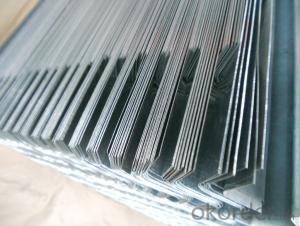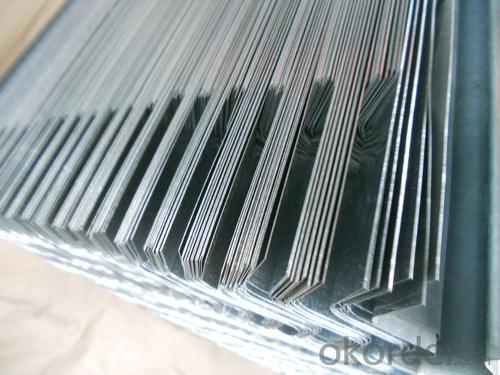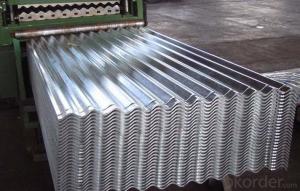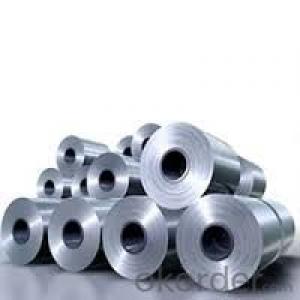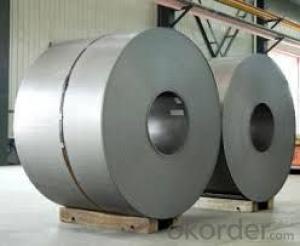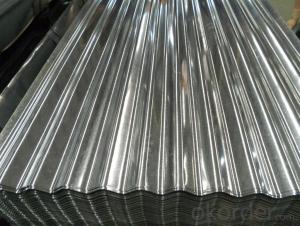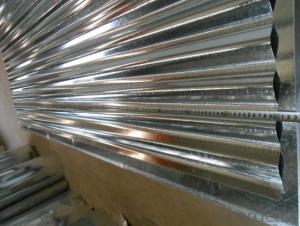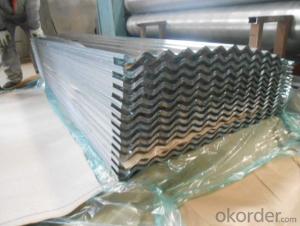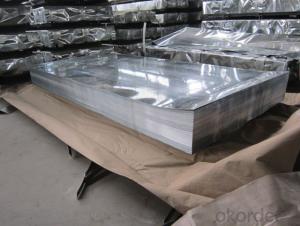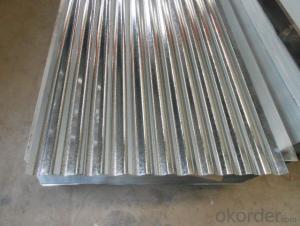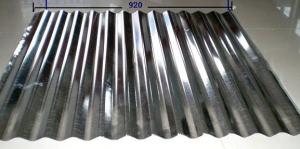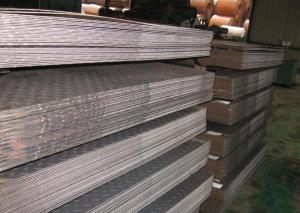Corrugated Hot-Dipped Galvanized Steel Sheet
- Loading Port:
- Tianjin
- Payment Terms:
- TT OR LC
- Min Order Qty:
- 50 m.t.
- Supply Capability:
- 1000 m.t./month
OKorder Service Pledge
OKorder Financial Service
You Might Also Like
Corrugated Hot Dipped Galvanized Steel Sheet
Description:
The corrugated sheet is a high strength and durable steel, mostly used for a architectural decoration. We have scores of corrugated sheets production lines of different types, producing profiled sheets of all kinds of types and colors. Since it adopts high strength steel sheet and the dimension is designed reasonably, the corrugated sheets are widely used on roofs and walls of various buildings, which can be easily installed, be flexible and changeable, unrestricted by no factor of the buildings.
Pressing steel panel can be freely incised, it can satisfy the especially designing demands. It apply on convenient construction, and anti-seismic performance, fire proof, waterproof, free of maintenance, ect.
Base sheet : galvanized steel sheet, pre painted galvanized steel sheet
Application:
It has been widely applied on civil construction like storerooms, special building roof and walls of wide-span steel structure building and so on.
Pressing steel panel with the clear line, and many colors for choice, suitable for any different building style materials, achieving satisfy effects;
Product Specification:
Thickness tolerance: (+/-0.01mm)
Zinc coating: 50-180g/m2
Standard:jis g 3302, sgch
Package: 2- 3 ton/pallet
Specs: 0.14-0.8mm x 900mm x 2000mm
Width:700-1250mm( 750mm,900mm,1215mm,1250mm,1000mm the most common)
Surface:regular/mini/zero spangle, chromated, skin pass, dry etc.
Package:Standard seaworthy export packing
FAQ:
1. Do you have pallets for the package?
Yes, we must use pallets for the package in order to load.
1.How many pieces for one package?
The pieces for one tone is decided by the thickness of the sheet, but we can make it according to your requirements in the reasonable range.
3. Could you produce the sheets according to our design?
Yes, we can make it.
- Q: Can the steel sheets be easily folded or creased?
- No, steel sheets cannot be easily folded or creased. Steel is a strong and rigid material that requires a significant amount of force to be bent or creased. It is commonly used in construction and manufacturing due to its durability and resistance to deformation. However, if the steel sheets are thin enough, they may be malleable enough to be bent or creased with the appropriate tools and techniques.
- Q: What is the difference between a steel sheet and a steel plate?
- A steel sheet and a steel plate have a few key differences. Firstly, the thickness of a steel sheet is generally less than 6mm, while a steel plate is typically thicker and measures 6mm or more. This difference in thickness is primarily due to the intended use of each product. Steel sheets are often used in applications where weight and flexibility are important, such as in the manufacturing of automobile bodies or appliances. On the other hand, steel plates are commonly utilized in heavy-duty constructions, such as bridges, buildings, or machinery, where strength and durability are paramount. Another difference lies in the manufacturing process. Steel sheets are typically produced through hot rolling, which involves heating the steel above its recrystallization temperature and then passing it between rollers to achieve the desired thickness. Steel plates, on the other hand, can be produced through hot rolling or cold rolling processes. Cold rolling involves passing the steel through rollers at room temperature, resulting in a more precise and smoother surface finish. Additionally, the size of steel sheets and plates also varies. Steel sheets tend to be standardized in terms of width and length, making them easier to handle and transport. Steel plates, on the other hand, are available in various sizes and dimensions, allowing for greater customization to suit specific project requirements. In summary, the primary differences between a steel sheet and a steel plate lie in their thickness, manufacturing process, and intended use. While steel sheets are thinner and more lightweight, steel plates are thicker and employed in heavy-duty applications that require strength and durability.
- Q: Can steel sheets be used for storage cabinets or lockers?
- Yes, steel sheets can be used for storage cabinets or lockers. Steel is a popular choice for these purposes due to its durability, strength, and resistance to damage. Steel sheets provide a sturdy and secure storage solution, making them ideal for cabinets and lockers. Additionally, steel is resistant to corrosion, which ensures that these storage units will last for a long time. The versatility of steel sheets allows for customization in terms of size, shape, and design, making it possible to create storage cabinets or lockers that meet specific requirements and fit seamlessly into any space.
- Q: Can steel sheets be used for interior wall applications?
- Yes, steel sheets can be used for interior wall applications. Steel sheets are a versatile material that can provide durability, strength, and an industrial aesthetic to interior walls. They are commonly used in commercial spaces, modern homes, and industrial buildings, providing a sleek and contemporary look. Additionally, steel sheets can be painted or treated to achieve various finishes and can be easily installed and maintained.
- Q: How do steel sheets compare to glass sheets?
- Steel sheets and glass sheets have distinct characteristics that make them suitable for different applications. Firstly, steel sheets are known for their strength and durability. They can withstand heavy loads and are highly resistant to impact and damage. This makes them ideal for construction purposes, such as in the manufacturing of buildings, bridges, and machinery. Additionally, steel sheets offer excellent protection against fire and extreme weather conditions. On the other hand, glass sheets are valued for their transparency and aesthetic appeal. They allow natural light to pass through, creating a bright and open atmosphere. Glass sheets are commonly used in windows, doors, and architectural structures to provide visibility and enhance the visual appeal of a space. Furthermore, glass sheets offer excellent thermal insulation properties, which can help reduce energy consumption in buildings. In terms of maintenance, steel sheets require minimal upkeep as they are resistant to corrosion and do not require regular cleaning. However, they may require painting or protective coatings to prevent rusting. On the contrary, glass sheets may need regular cleaning to maintain their transparency and appearance. They are also more prone to scratching and breakage compared to steel sheets. Lastly, cost is an important factor to consider. Steel sheets typically have a lower initial cost compared to glass sheets. However, the overall cost may vary depending on factors such as size, thickness, and quality. Additionally, the cost of installation and maintenance should also be taken into account. In conclusion, steel sheets and glass sheets have their own unique characteristics and properties. The choice between the two would depend on the specific requirements of the project, including strength, transparency, aesthetics, maintenance, and cost considerations.
- Q: What is the difference between a perforated and expanded steel sheet?
- A perforated steel sheet and an expanded steel sheet are both types of metal sheets commonly used in various industries. However, they differ in terms of their manufacturing process and resulting characteristics. Perforated steel sheets are created by punching or drilling holes into a solid steel sheet. These holes can be of various shapes, sizes, and patterns, depending on the desired application. The holes in a perforated steel sheet allow for the passage of air, light, sound, or fluids, making them suitable for applications that require ventilation, filtration, or acoustic properties. Perforated steel sheets are commonly used in industries such as architecture, automotive, filtration, and mining. On the other hand, expanded steel sheets are produced by a unique manufacturing process known as expanding. The process involves cutting and stretching a solid steel sheet, resulting in a mesh-like pattern with diamond-shaped openings. The stretching process imparts strength and rigidity to the steel sheet while also reducing its weight. Expanded steel sheets are versatile and can be used in applications such as walkways, platforms, fencing, grating, and reinforcement. In summary, the main difference between a perforated and expanded steel sheet lies in their manufacturing process and resulting characteristics. Perforated steel sheets have holes punched or drilled into them, allowing for the passage of air, light, sound, or fluids. Meanwhile, expanded steel sheets are created by cutting and stretching a solid sheet, resulting in a mesh-like pattern with diamond-shaped openings. Both types of sheets have their unique advantages and are chosen based on the specific requirements of the application.
- Q: What is the price of each steel sheet?
- The price of each steel sheet may vary depending on various factors such as size, thickness, quality, and market conditions. It is best to check with steel suppliers or manufacturers to get an accurate and up-to-date price for the specific steel sheet you are interested in purchasing.
- Q: Can steel sheets be used for manufacturing automotive parts?
- Yes, steel sheets can be used for manufacturing automotive parts. Steel sheets are widely used in the automotive industry due to their strength, durability, and cost-effectiveness. They can be easily formed, welded, and shaped into various automotive components such as body panels, chassis parts, and structural elements.
- Q: Are the steel sheets resistant to impact or bending?
- Yes, steel sheets are generally resistant to both impact and bending. Steel is known for its high strength and durability, making it less likely to be affected by external forces such as impacts or bending. This is due to the material's ability to absorb and distribute the energy applied to it, resulting in minimal deformation or damage. However, the specific resistance to impact and bending may vary depending on the thickness, type of steel, and any additional treatments or coatings applied to the sheets.
- Q: Can steel sheets be recycled after use?
- Yes, steel sheets can be recycled after use. Steel is a highly recyclable material, and recycling steel sheets helps to conserve energy and reduce the need for raw materials in steel production.
Send your message to us
Corrugated Hot-Dipped Galvanized Steel Sheet
- Loading Port:
- Tianjin
- Payment Terms:
- TT OR LC
- Min Order Qty:
- 50 m.t.
- Supply Capability:
- 1000 m.t./month
OKorder Service Pledge
OKorder Financial Service
Similar products
Hot products
Hot Searches
Related keywords
